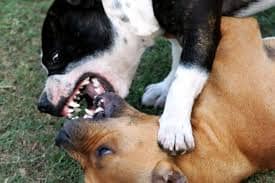Types of Dog Aggression
There are many different types of dog aggression. Below are descriptions and signs to look for for dog aggression
- Fear-Based Aggression
- Description: This type of aggression occurs when a dog perceives a threat and believes that aggression is the only way to escape the threat. It’s often seen in dogs who lack confidence or have had negative experiences in the past.
- Signs: Cowering, trembling, avoidance, and then sudden aggression when cornered.
- Territorial Aggression
- Description: Dogs exhibiting territorial aggression will protect their space (home, yard, even car) from perceived intruders.
- Signs: Barking, lunging, or biting when someone approaches their territory.
- Protective Aggression
- Description: Similar to territorial aggression but focused on protecting a person or other pets in the household.
- Signs: Aggressive behaviors manifest when they perceive a threat to a member of their social group.
- Possessive Aggression
- Description: This occurs when dogs aggressively guard resources, such as food, toys, or even people.
- Signs: Growling, snapping, or biting when someone approaches their valued resource.
- Predatory Aggression
- Description: This is a more instinctual form of aggression, often triggered by moving stimuli and less inhibited by socialization.
- Signs: Chasing, nipping, or biting moving objects, small animals, or even running children.
- Pain-Induced Aggression
- Description: Aggression can be a response to pain, especially if the dog is touched in a painful area or if their movement causes discomfort.
- Signs: Sudden aggression when in pain or discomfort.
- Social Aggression
- Description: Stemming from social interactions with other dogs, this aggression is about establishing or maintaining social order.
- Signs: Aggression during interactions with other dogs, often related to body language and social cues.
- Frustration-Elicited Aggression
- Description: Occurs when a dog is frustrated at not being able to reach a goal (like seeing another dog while on a leash) and turns to aggression.
- Signs: Barking, lunging, or aggressive behaviors in situations of frustration or restraint.
- Redirected Aggression
- Description: When a dog cannot direct aggression toward the source of their arousal or frustration, they may redirect it to someone or something else.
- Signs: Aggressive behaviors towards a nearby person or animal when the primary source of arousal is inaccessible.
Causes of Dog Aggression
- Genetic Predisposition
- Certain breeds may have a higher propensity for specific types of aggression, though it’s crucial to note that not all individuals within a breed will exhibit aggression.
- Early Socialization and Experiences
- Lack of proper socialization during the critical puppyhood period can lead to fearfulness and aggression. Traumatic experiences can also contribute.
- Training and Handling
- Harsh or punitive training methods can exacerbate aggressive tendencies. Inconsistent or unclear communication can also contribute.
- Health and Pain
- Medical issues, including chronic pain, hormonal imbalances, and neurological disorders, can lead to aggression.
- Environmental Stressors
- Changes in the environment, overcrowding, lack of exercise, and inadequate mental stimulation can contribute to stress-induced aggression.
- Fear and Anxiety
- Dogs with generalized anxiety or specific phobias may exhibit aggression as a response to their fear.
- Resource Guarding Instincts
- Some dogs have a strong instinct to guard resources, which can lead to possessive aggression.
- Lack of Leadership and Structure
- Dogs lacking clear and consistent guidance from their pet guardians may exhibit social aggression as they try to navigate their social environment.
- Frustration
- Situations, where dogs are repeatedly frustrated (e.g., always seeing but never interacting with other dogs), can lead to frustration-elicited aggression.
Conclusion
Understanding and addressing dog aggression is a complex task that requires identifying the type of aggression and its underlying causes. Each case is unique and necessitates a tailored approach that considers the dog’s history, environment, and specific triggers. Management and modification strategies often involve a combination of behavior modification techniques, environmental management, and sometimes medical intervention.


